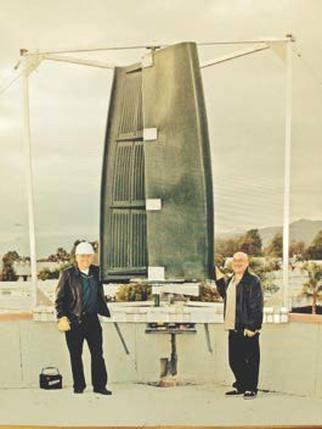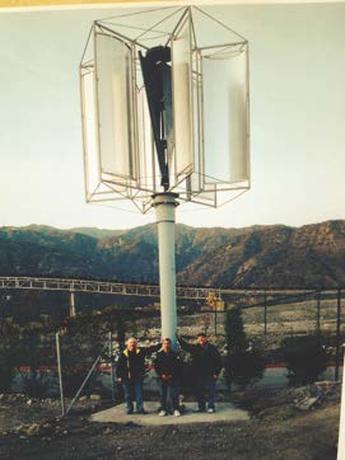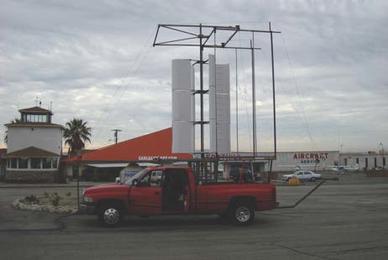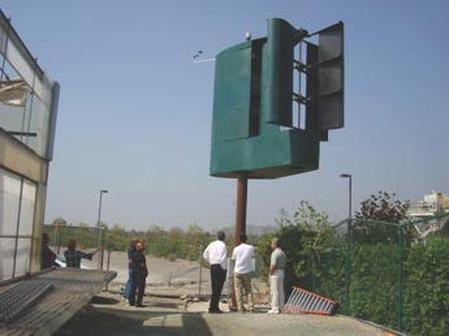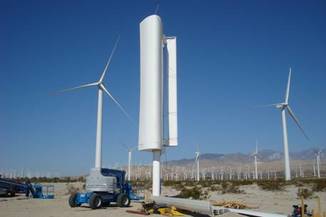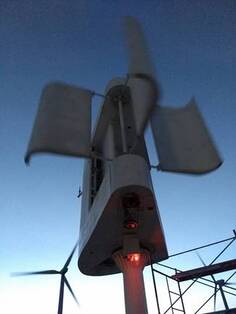The Evolution of the Cali e-Power 12 kW design
For the past fifteen years the conceptual design was in a state of continual refinement and evolution. The current CALI e-Power 12 kW design is a culmination of eleven years of an interactive steady improvement Kaizen design process. Much has been learned through the evolution to the current design CE&P has today.
Here is a summary of the major milestones of our current Cali e-Power 10kw design.
Here is a summary of the major milestones of our current Cali e-Power 10kw design.
Design Generation 1 (2006)
|
Design Generation 2 (2008)
|
1 KW turbine built at Colorama, CA – 2 blades and the introduction of a six fixed concentrator scoops solution
Initial Design Objective: Build, test and operated a two bladed helix style turbine with six fixed wind concentrators with was CE&P’s first attempt to pursue a “wind collector” approach. Lesson Learned: It was learned that the fixed concentrator simply produced a high air pressure zone around the six fixed concentrators, preventing wind from entering the machine, and allowing extraction of potential energy. The efficiency was CE&P’s second-generation design was estimated to be no more than 17%. |
| |
|
Lesson Learned: The single dynamic air-foil concentrator did increase energy and direct of the wind into the working surfaces of the turbine blades, and also shielded the blades of the turbine in their “return” position, thereby producing a measured efficiency of over 30%. The shielding of the turbine blades in the “return” position was a major design advancement, and the ability to orient the turbine blade for a “controlled and managed” turbine blade RPM . Previous designs of turbines to this date without the “concentrator” design make them prone to vibration problems and relatively lower efficiencies.
|
|
A major breakthrough!!
Dr. Gharib at the California Institute of Technology used data taken from this third generation design and testing at the Cable Airport, to review and confirmed efficiencies of approximately 2X the current market.. This also confirmed that a 4-blade design was a dramatic improvement from the previous 2-blade designs. A 3 kW Prototype was built (2009 -2010) based on this third generation 1 kW design at Colorama, CA; 4- blades and moving concentrator design |
|
Initial Design Objective: Build, test and operate as a grid connected wind turbine a 3 KW one-off beta turbine to demonstrate that the turbine could be moved into the correct relative position to the on-coming wind by means of an anemometer, and wind vane detecting the direction of the wind, and the speed of the wind using a Programmable Logic Controller (PLC) and electric positioning motor. Lesson Learned: CE&P learned that a 3 kW vertical turbine can be driven into the correct relative position to the wind by means of a PLC controller, anemometer and wind vane, and a confirmation of the generation 3 control system design. |
Design Generation 4 (2011-2012)
|
First Cal e-Power 10 kW turbine with molded protruded technology assembled in Palm Springs, CA called Palm Springs 1, or PS1
Initial Design Objective: To build, test and operate a grid connected 10 kW vertical axis wind turbine with protruded glass and resin blades and concentrator sections. CE&P also sought to prove that this design for a 10 kW vertical turbine could be installed in the field. |
|
Lesson Learned: We need to improve a number of design features of the CE&P 10 kW turbine, including the way in which the “concentrator" is built and assembled and knowledge of the proper “size/scale” issues. The other major components were installed as designed (tower sections, blades, drive arms, holding arms, top cap and nacelle), but we learned that the sequence of installation and off-site assemblies is of vital importance to the overall time, cost and overall success of each installation. We also learned ways to make various parts and subassemblies more reliable, streamlined and less costly.
|
Design Generation 5 (2017-2022)
|
|
The thrust of the evolution of our technology is that through our experience CE&P has learned the “helix” style turbine design, and traditional turbine designed today deployed without protected and directed wind flow are fundamentally flawed for commercial purposes, and so have elected to pursue a higher efficiency design path with the development of “Concentrated Controlled Wind” solutions aided by Computational Fluid Dynamic modeling (CFD) carried out in collaboration with Caltech, prototyping, and our new engineering teams of Precision Design Advantage, LLC a division of Armor Engineering and EV Enterprises, and manufactured by Quicksilver Industries, LLC. |

